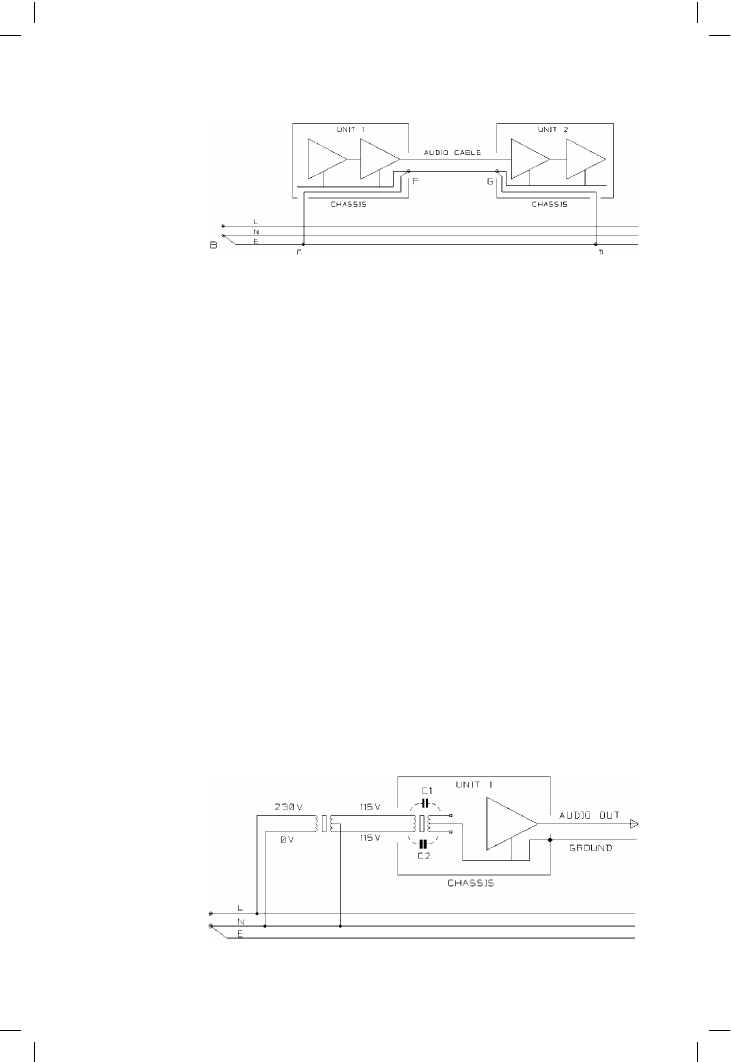ВУЗ: Казахская Национальная Академия Искусств им. Т. Жургенова
Категория: Учебное пособие
Дисциплина: Не указана
Добавлен: 03.02.2019
Просмотров: 17344
Скачиваний: 18

Audio Power Amplifier Design Handbook
a powered subwoofer, which is likely to have a larger transformer than
other components of the system.
Equipment type
Power
consumption
Ground
current
Turntable, CD, cassette deck
20 W or less
5 µA
Tuners, amplifiers, small TVs
20–100 W
100 uA
Big amplifiers, subwoofers, large TVs
More than 100 W
1 mA
Ground currents inside equipment
Once ground currents have been set flowing, they can degrade system
performance in two locations: outside the system units, by flowing in the
interconnect grounds, or inside the units, by flowing through internal PCB
tracks, etc. The first problem can be dealt with effectively by the use of
balanced inputs, but the internal effects of ground currents can be much
more severe if the equipment is poorly designed.
Figure 14.5 shows the situation. There is, for whatever reason, ground
current flowing through the ground conductor CD, causing an interfering
current to flow round the loop CFGD as before. Now, however, the
internal design of Unit 2 is such that the ground current flowing through
FG also flows through G–G’ before it encounters the ground wire going
to point D. G–G’ is almost certain to be a PCB track with higher
resistance than any of the cabling, and so the voltage drop across it can
be relatively large, and the hum performance correspondingly poor.
Exactly similar effects can occur at signal outputs; in this case the ground
current is flowing through F–F’.
Balanced inputs will have no effect on this; they can cancel out the voltage
drop along F–G, but if internal hum is introduced further down the internal
signal path, there is nothing they can do about it.
410
Figure 14.5
If ground current flows
through the path
F‘FGG’ then the
relatively high
resistance of the PCB
tracks produces
voltage drops between
the internal circuit
blocks

Grounding and practical matters
The correct method of handling this is shown in Figure 14.6. The
connection to mains ground is made right where the signal grounds leave
and enter the units, and are made as solidly as possible. The ground current
no longer flows through the internal circultry. It does, however, still flow
through the interconnection at FG, so either a balanced input or a ground-
cancelling output will be required to deal with this.
Balanced mains power
There has been speculation in recent times as to whether a balanced mains
supply is a good idea. This means that instead of live and neutral (230 V and
0 V) you have live and the other live (115 V–0–115 V) created by a centre-
tapped transformer with the tap connected to Neutral. See Figure 14.7.
It has been suggested that balanced mains has miraculous effects on sound
quality, makes the sound stage ten dimensional, etc. This is obviously
nonsense. If a piece of gear is that fussy about its mains (and I don’t believe
any such gear exists) then dispose of it.
If there is severe RFI on the mains, an extra transformer in the path may tend
to filter it out. However, a proper mains RFI filter will almost certainly be
more effective – it is designed for the job, after all – and will definitely be
much cheaper.
Where you might gain a real benefit is in a Class II (i.e. double-insulated)
system with very feeble ground connections. Balanced mains would tend
411
Figure 14.6
The correct method of
dealing with ground
currents; they are
diverted away from
internal circuitry
Figure 14.7
Using a balanced
mains supply to cancel
ground currents
stemming from inter-
winding capacitance
in the mains
transformer. An
expensive solution

Audio Power Amplifier Design Handbook
to cancel out the ground currents caused by transformer capacitance (see
Figure 14.4 and above for more details on this) and so reduce hum. The
effectiveness of this will depend on C1 being equal to C2 in Figure 14.7,
which is determined by the details of transformer construction in the unit
being powered. I think that the effect would be small with well-designed
equipment and reasonably heavy ground conductors in interconnects.
Balanced audio connections are a much cheaper and better way of
handling this problem, but if none of the equipment has them then beefing
up the ground conductors should give an improvement. If the results are
not good enough then as a last resort, balanced mains may be worth
considering.
Finally, bear in mind that any transformer you add must be able to handle
the maximum power drawn by the audio system at full throttle. This can
mean a large and expensive component.
I wouldn’t be certain about the whole of Europe, but to the best of my
knowledge it’s the same as the UK, i.e. not balanced. The neutral line is at
earth potential, give or take a volt, and the live is 230 V above this. The
3-phase 11 kV distribution to substations is often described as ‘balanced’
but this just means that power delivered by each phase is kept as near equal
as possible for the most efficient use of the cables.
It has often occurred to me that balanced mains 115 V–0–115 V would be
a lot safer. Since I am one of those people that put their hands inside live
equipment a lot, I do have a kind of personal interest here.
Class I and Class II
Mains-powered equipment comes in two types: grounded and double
insulated. These are officially called Class I and Class II respectively.
Class I equipment has its external metalwork grounded. Safety against
electric shock is provided by limiting the current the live connection can
supply with a fuse. Therefore, if a fault causes a short-circuit between live
and metalwork, the fuse blows and the metalwork remains at ground
potential. A reasonably low resistance in the ground connection is essential
to guarantee the fuse blows. A three-core mains lead is mandatory. Two-
core IEC mains leads are designed so they cannot be plugged into three-pin
Class I equipment. Class I mains transformers are tested to 1.5 kV rms.
Class II equipment is not grounded. Safety is maintained not by interrupting
the supply in case of a fault, but by preventing the fault happening in the
first place. Regulations require double insulation and a generally high
standard of construction to prevent any possible connection between live
and the chassis. A two-core IEC mains lead is mandatory; it is not permitted
to sell a three-core lead with a Class II product. This would present no
hazard in itself, but is presumably intended to prevent confusion as to what
412

Grounding and practical matters
kind of product is in use. Class II mains transformers are tested to 3 kV rms,
to give greater confidence against insulation breakdown.
Class II is often adopted in an attempt to avoid ground loops. Doing so
eliminates the possibility of major problems, at the expense of throwing
away all hope of fixing minor ones. There is no way to prevent capacitance
currents from the mains transformer flowing through the ground connec-
tions. (See section ‘Ground loops: how they work and how to deal with,
them’ on page 405). It is also no longer possible to put a grounded
electrostatic screen between the primary and secondary windings. This is
serious as it deprives you of your best weapon against mains noise coming
in and circuit RF emissions getting out. In Class II the external chassis may
be metallic, and connected to signal 0 V as often as you like.
If a Class II system is not connected to ground at any point, then the
capacitance between primaries and secondaries in the various mains
transformers can cause its potential to rise well above ground. If it is
touched by a grounded human, then current will flow, and this can
sometimes be perceptible, though not directly, as a painful shock like static
electricity. The usual complaint is that the front panel of equipment is
‘vibrating’, or that it feels ‘furry’. The maximum permitted touch current
(flowing to ground through the human body) permitted by current
regulations is 700 µA, but currents well below this are perceptible. It is
recommended, though not required, that this limit be halved in the tropics
where fingers are more likely to be damp. The current is measured through
a 50k resistance to ground.
When planning new equipment, remember that the larger the mains
transformer, the greater the capacitance between primary and secondary,
and the more likely this is to be a problem. To put the magnitudes into
perspective, I measured a 500 VA toroid (intended for Class II usage and
with no interwinding screen) and found 847 pF between the windings. At
50 Hz and 230 V this implies a maximum current of 63 µA flowing into the
signal circuitry, the actual figure depending on precisely how the windings
are arranged. A much larger 1500 VA toroidal transformer had 1.3 nF
between the windings, but this was meant for Class I use and had a screen,
which was left floating to get the figure above.
Warning
Please note that the legal requirements for electrical safety are always liable
to change. This book does not attempt to give a complete guide to what is
required for compliance. The information given here is correct at the time
of writing, but it is the designer’s responsibility to check for changes to
compliance requirements. The information is given here in good faith but
the author accepts no responsibility for loss or damage under any
circumstances.
413

Audio Power Amplifier Design Handbook
Mechanical layout and design considerations
The mechanical design adopted depends very much on the intended
market, and production and tooling resources, but I offer a few purely
technical points that need to be taken into account:
Cooling
All power amplifiers will have a heatsink that needs cooling, usually by free
convection, and the mechanical design is often arranged around this
requirement. There are three main approaches to the problem:
(a) The heatsink is entirely internal, and relies on convected air entering
the bottom of the enclosure, and leaving near the top (passive
cooling).
Advantages
The heatsink may be connected to any voltage, and this may eliminate the
need for thermal washers between power device and sink. On the other
hand, some sort of conformal material is still needed between transistor and
heatsink. A thermal washer is much easier to handle than the traditional
white oxide-filled silicone compound, so you will be using them anyway.
There are no safety issues as to the heatsink temperatures.
Disadvantages
This system is not suitable for large dissipations, due to the limited fin area
possible inside a normal-sized box, and the relatively restricted convection
path.
(b) The heatsink is partly internal and partly external, as it forms one or
more sides of the enclosure. Advantages and disadvantages are much as
above; if any part of the heatsink can be touched then the restrictions on
temperature and voltage apply. Greater heat dissipation is possible.
(c) The heatsink is primarily internal, but is fan-cooled (active cooling).
Fans always create some noise, and this increases with the amount of
air they are asked to move. Fan noise is most unwelcome in a domestic
hi-fi environment, but is of little importance in PA applications.
This allows maximal heat dissipation, but requires an inlet filter to
prevent the build-up of dust and fluff internally. Persuading people to
regularly clean such filters is near-impossible.
Efficient passive heat removal requires extensive heatsinking with a free
convective air flow, and this indicates putting the sinks on the side of the
amplifier; the front will carry at least the mains switch and power indicator
light, while the back carries the in/out and mains connectors, so only the
sides are completely free.
414